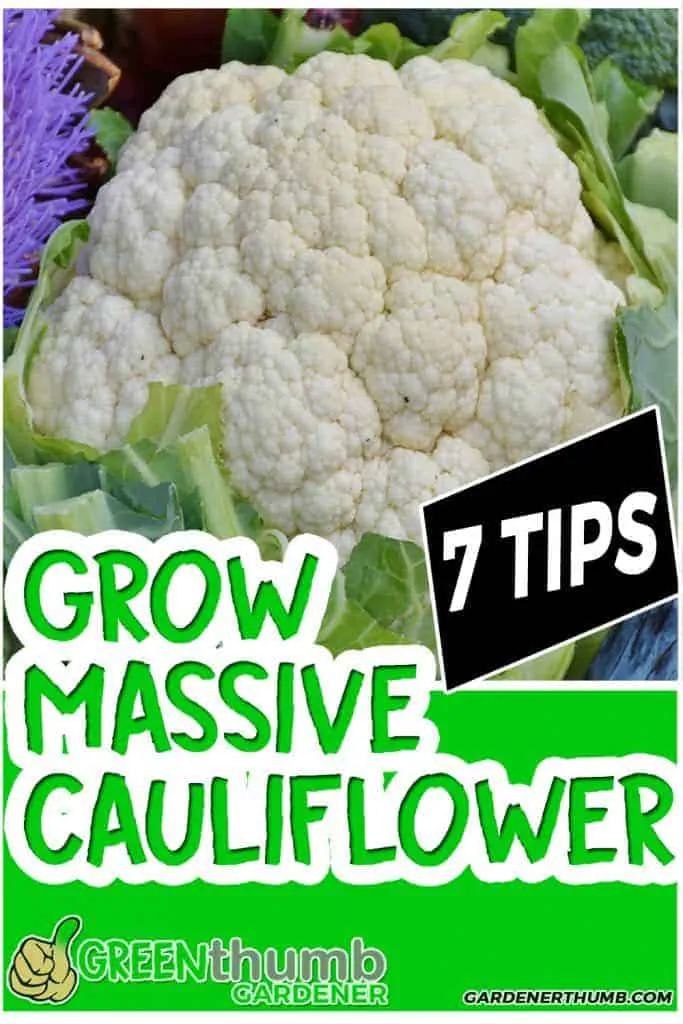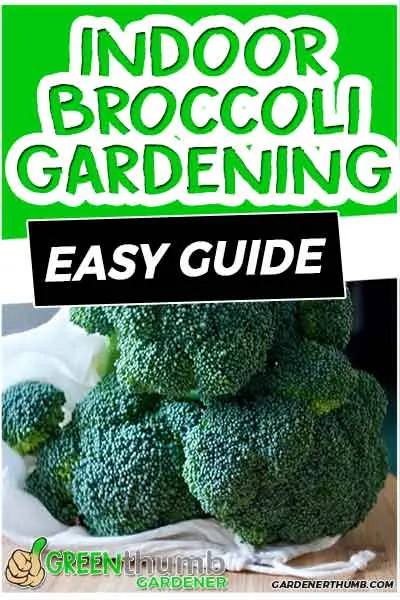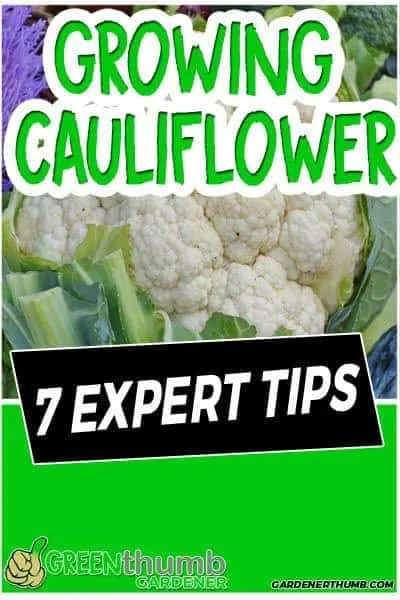How To Grow Cauliflower | 7 Tips to Avoid the Small Curds
Last updated: 10/31/21
I am sitting here laughing because many of you may associate curds with souring milk. Maybe little Miss Muffet who sat on her tuffet eating her curds and whey. I can assure you Little Miss Muffet was not learning how to grow cauliflower.
The curd is the fancy word for the dense brassica head that you get when you successfully grow cauliflower. It is the white stuff on the cauliflower that you roast up or you cook to eat. The bigger the better is really the essence of how to grow cauliflower.
Grow cauliflower is probably not the first vegetable to start your gardening adventure because it can be challenging to grow. You definitely need a game plan and a strategy to grow cauliflower successfully but don’t fret because the tips here will serve to help you grow some big ass curds.
Green thumb Gardener occasionally links to product and/or services offered by vendors to assist you with all your gardening needs. Some of these may be affiliate links, meaning we earn a small commission if items are purchased.
Want to Download a Garden Hack Guide for FREE

Enter your email below and we will send you a guide to help you SAVE money in your garden.
Tip#1 | Time it Right to Grow Cauliflower
One of the key factors to learn how to grow cauliflower is getting the timing of when to plant.
Cauliflower is one of the plants that you want to grow during the cooler months of the year. You definitely don’t want to start growing cauliflower during your next heatwave.
For a spring crop, it is best to start growing cauliflower in a seed tray so you can later transplant out int your garden or container.
Check your calendar and figure out your last frost date and aim for about 40-60 days before that date to know when to start it.
For a fall crop, you want to start it about 60-90 days before the first frost date.
Just be careful about planting it too early in either season as cauliflower is very finicky. Getting the timing right is vital to ensure you get the big curds for your cauliflower.

Tip #2 | Moisture Requirements for Planting Cauliflower
Another key lesson that you need to know about growing cauliflower successfully is to ensure that it has proper watering. One of the signals that mother nature endowed plants is to know when its time to check out. Dry soil conditions seem to be one of those triggers.
Make sure that you keep your moisture levels in check with cauliflower especially as it starts to warm up for your spring crop. Cauliflower requires about 1 inch of water each week in order to grow successfully
Tip #3 | Feeding your Big Curds | Cauliflower Plant Nutrition
It is true that cauliflower needs to eat too. Cauliflower really needs a ton of nutrients to grow. You need to make sure that you maximize your chances of growing big curds by starting things off right.
Boost your soil before you actually transplant or start your cauliflower seeds. This is a key step to perfecting the art of how to grow cauliflower. You really should get this right if you want to grow any vegetable for that matter.
Make sure that the soil has a good complete amount of NPK in the form of compost or any other organic matters added to it. Blood meal, Bone meal and rock dust are all good organic sources that you can use. We prefer good old worm castings too.
Now, that you have the soil loaded with good amounts of fertilizers you want to pay attention to supplemental feeding schedules for cauliflower. Your organic fertilizers may need some time to break down, so don’t be afraid to give it a boost when you first plant with some liquid fertilizers.
Give your cauliflower plants another supplemental feeding and a side dressing of compost about every month and you should be golden until you harvest.
Tip #4 | Mulching Your Cauliflower Beds | Head off the Problems with Prevention
There really is not much to it with this tip. “An ounce of prevention is worth a pound of cure” is the old saying.
Another key skill in learning how to grow cauliflower is to ensure that you keep the moisture in check.
Yes, this has been mentioned before in Tip#2, but it needs to be stressed again. Another key barometer that mother nature gave her plants is these temperature gauges.
The soil temperatures are one of those ways that plants react.
Your job or mission if you choose to accept it is to keep your plants happy and provide somewhat of a stable environment.
Well, there is only so much you can do, so be ok with that.

However, mulching your cauliflower plants will do 2 things to help them grow successfully:
- Keep moisture levels at a constant– The evaporation of moisture is definitely slowed down by adding a thick layer between your cauliflower plants.
- Soil temperature is lower– Think of the mulching your cauliflower plants as insulation between the outside and the roots of the cauliflower. As the summer approaches, it gets much warmer and the soil temperatures will start to climb. Cauliflower does not like warmer temperatures.
Mulching is really a good all-around garden hack. It helps in many ways to keep things in balance with mother nature. A simple mulch of untreated tree bark or straw (not hay as it has seeds) should do the trick.
Tip #5 | Blanching Cauliflower Heads
Oh geez, are you asking me to get Blanche from the golden girls involved in this one? Not exactly, blanching is the simple method of shielding the cauliflower heads from the sun. It is a necessary step if you want some fluffy white curds.
You want to look to do this when the cauliflower is about the size of a doorknob or a child’s fist. The perfect way to get your kid excited for growing cauliflower. Your child will be out there every day checking their fist against the cauliflower.
Some varieties of cauliflower are self-blanching, but you might still want to take this extra step. A really simple way is to take some of the leaves of the cauliflower and wrap it around the cauliflower. You can either tie it with some twine or fasten a rubber band around it.
Another option if you don’t want to worry about blanching cauliflower is to grow a different colored variety. Cheddar is a bright yellow cauliflower variety that is gorgeous. Check out some Cheddar cauliflower variety seeds here.
Check out our mega guide to growing cauliflower here. Our guide is packed with more helpful information about how to properly blanch cauliflower.

Further Reading
Tip #6 | Cauliflower Curd Problems
You may encounter some foes along with the ways of growing cauliflower. In fact, learning how to grow cauliflower includes learning about techniques to identify the common issues before they happen. Aphids and caterpillars always seem to show up to our garden patch during the spring.
The best way to know what is going on with your cauliflower is to check them often. Get out there and examine them closely should you notice any issues creeping out before they get out of hand.
Another tip is to make sure you rotate your cauliflower crops each year. This is an overall good practice to do with all of your vegetables. Crop rotation helps with the prevention of many diseases that can affect your cauliflower.
Tip # 7 | Harvesting Cauliflower
You made it to the finish line. Don’t worry if your cauliflower curd is not as big as you wanted it to be. Growing cauliflower is one of the more challenging vegetables to grow. Learning how to grow cauliflower makes you an expert in applying sunscreen and adding force field around your plant.
Well, it is not that bad. You will know that cauliflower is mature when the size of the head is about 8-12 inches across. You want to make sure the buds are nice and tight and not open. Use a sharp knife and cut them just below the head.
Unfortunately, cauliflower does not develop side shoots after they are cut as their cousin broccoli does. You can just pull up the plant after you cut them. Another option to allow you to store it longer is to pull up the entire plant and hang it in your storage cellar.
More Info | Cauliflower Closure
Following these 7 tips will teach how to grow cauliflower in no time so you can impress your friends without small curds. That was a mouth full. Get out there and get your hands dirty. You can always learn more about growing cauliflower. Check out our mega guide here.
Additional Questions
- How to Grow Cauliflower from seed? – Cauliflower can definitely be grown from seed. Growing cauliflower from seed will also give you a better selection of varieties than in the garden centers. You should look for seeds that have a high germination rate and start the seeds in seed flats.
- Can Cauliflower be grown in containers or pots? – Yes, cauliflowers can be grown from containers or pots. Be aware that you will need to ensure that it has good access to soil nutrients and that you keep the soil evenly moist throughout its growing cycle.
- How long does it take cauliflower to grow? – Cauliflower takes about 14 weeks from seed to harvest.








